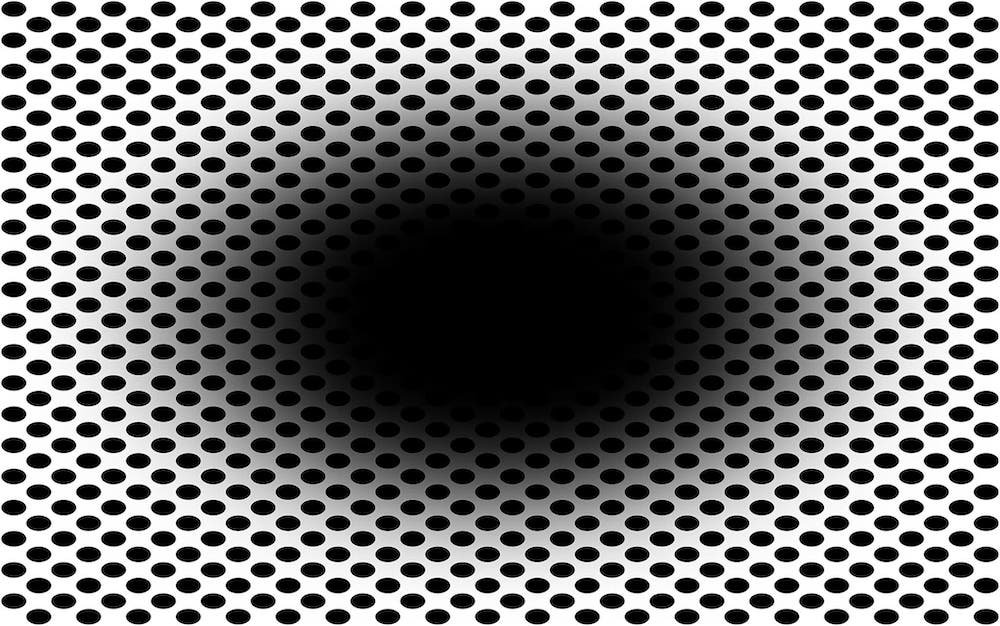Black Holes and Lecture Patter
/Consider this optical illusion of a black hole which seems to shift and grow as you look at it.
Here’s a New York Times article that explains how the movement people see in this picture is possibly caused by your brain trying to anticipate the near future.
From the article:
One hypothesis, Dr. Laeng said, is that the brain is trying to predict and show us the future.
It takes time for a stimulus, like light, to reach our sensory organs, which need to send it to the brain, which in turn needs to process, make sense of, and do something with that information. And by the time our brain catches up with the present, time has already moved forward, and the world has changed.
To get around this, the brain may be constantly trying to predict a little bit into the future in order to perceive the present.
Seeing the expanding hole illusion is not a flaw, but a feature: It’s the result of your brain’s strategy to navigate an uncertain, ever-changing world, most likely built up from evolutionary history to ultimately help humanity survive. It is adaptive to predict the future by, say, dilating your pupils in anticipation of going somewhere dark.
Knowing that’s what potentially causing the illusion, this image could make a good Imp or Hook for a prediction effect. Or a lead-in to a spectator as mentalist plot where the illusion is used to identify someone with potential prediction capabilities.
But how do you incorporate things like this in a trick in casual situations? The wrong way, in my opinion, is to do something like this:
“Take a look at this image of a black hole. Does it seem to move and expand as you look at it? I’ll tell you why that is. It takes time for light to reach our sensory organs which need to process that information and send it to our brain. And in that time things have already moved forward. So the brain is constantly trying to predict a little bit into the future. In this case, your pupils are dilating in anticipation of going into a dark hole. And it’s this dilation of the pupils that causes the image to seem to grow. If your mind is good at anticipating the future, let’s see if we can exploit that in other ways.”
I call this sort of thing “Lecture Patter.” It sounds like you’re listening to a rehearsed lecture. It’s not the way friends talk when they get together. It says, “I’ve anticipated this moment and prepared for it and you are just the person I decided to unleash this on. Pat attention. Class is in session.” Everything feels pre-planned.
So here’s how I use something like this. One of my favorite summer activities is to meet a friend in the late evening at an ice cream stand. We sit on the hood of my car and catch up and stuff our faces with ice cream. What’s better than that?
This is not the time to give a dissertation on the fucking human retina or something.
But, as often happens, we might scan through some pictures on our phones to show the other person. In that process, I stumble over an image I saved to my phone from something I had been reading.
“Oh hey. Take a look at this. Does that black spot look like it’s moving or growing to you?”
She says yes. I straighten up. “Oh yeah? It’s definitely noticeable? Cool. I’ve shown it to a few people but you’re the first to really see it. I mean, almost everyone sees it a little bit. But you’re the first one to really notice it. Interesting. Hmm… there’s something I want to try with you later.” Later could be later that night, next week, or whenever.
Whenever “later” arrives, I can now give a couple of sentences of exposition. “Remember that picture I showed you with the black spot that seemed to grow? Well, apparently what causes that is that your mind sees the hole and your brain is predicting the immediate future of going into that hole. Because of the perspective of the image, I think. So your mind sees the hole growing as if you’re getting closer because that’s what it expects.”
This isn’t exactly what’s happening, but it’s close enough that even if they were to research it afterward, it would seem like I was in the same ballpark.
“At any rate, one of these weird mentalist guys that I’m friends with online was saying that picture is a good test to sort-of identify people with strong… like… I forget the exact phrase. Hyper-short-term-precognition. Or something like that. Being able to project your mind into the very near future. Because that’s who that image seems to work best with. And he came up with this little test I wanted to try with you.”
You see how this feels like a totally different interaction than the standard Lecture Patter version, yes? It feels like we’re discovering something together, rather than them being sat down for a formal presentation. I set the Hook at an earlier point in time. Very casually. I want them to feel like this is something unusual. Something I wasn’t prepared for. Their ability to really sense this optical illusion has supposedly told me something about them that I didn’t know. If I immediately transition into some trick as if I was prepared for this all along, that suggests the whole optical illusion thing was just a planned pretext.
And even when the time comes later, I’m still not some “expert” on the subject. I use a lot of qualifying words and phrases: “apparently,” “I think,” “I forget,” “something like that.” This is how people talk about subjects they lack certainty on.
Avoiding Lecture Patter is one of the ways we can make magic feel more spontaneous and unpredictable. Even though most people we perform for will understand magic is fake, and practiced, and scripted, you don’t have to perform in such a way that feeds into that feeling.
Thanks to David S. for tipping me off about this illusion last year.


